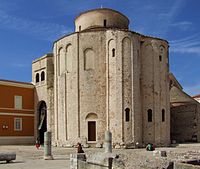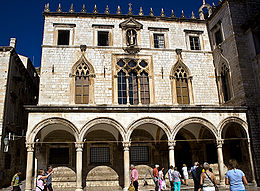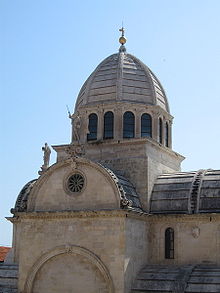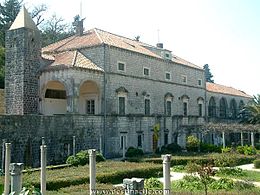- Architecture of Croatia
-
St Jacobs Cathedral, Šibenik

The architecture of Croatia has roots in a long history: the Croats have inhabited the area for thirteen centuries, but there are important remnants of the earlier periods still preserved in the country.
Contents
Ancient heritage
 Neolithic Bunja house near Šibenik
Neolithic Bunja house near Šibenik
The most interesting Copper Age finds are from Vučedol culture (named after Vučedol near Vukovar). In Vučedol People lived on hilltops with palisade walls. Houses were half buried, mostly square or circular (they were also combined in mushroom shape), with floor of burned clay and circular fireplace.
The Bronze culture of the Illyrians, an ethnic group with distinct culture and art form started to organize itself on today’s Croatia. Numerous monumental sculptures are preserved, as well as walls of citadel Nezakcij near Pula, one of numerous Istrian cities from Iron Age.
Greek sailors and merchants have reached almost every part of the Mediterranean including the shores of today’s Croatia; there they have founded city-states in which they lived quite isolated. Trade cities on the Adriatic shores such as Tragurion (today Trogir), Salona (Solin near Split), Epetion (today Poreč), Issa (Vis), were geometrically shaped and had villas, harbors, public buildings, temples and theatres. While the Greek colonies were flourishing on the island, on the continent the Illyrians were organizing their centers. Their art was greatly influenced by Greek art, and they have even copied some. In the Neretva delta there was an important influence of the Hellenistic Illyrian tribe of Daors.
 Restitution of Emperor Diocletian Palace in Split, c. 300 AD
Restitution of Emperor Diocletian Palace in Split, c. 300 AD
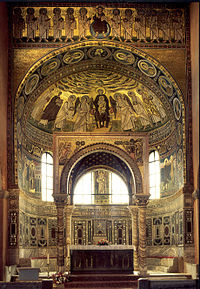 The apse of Euphrasian Basilica in Poreč
The apse of Euphrasian Basilica in Poreč
Romans[1] subdued the Greek colonial cities in 3rd century BC. They imposed an organization based on a military-economical system. Further more, the Romans subdued the Illyrians in the first century BC and organized the entire coastal territory by transforming the citadels into urban cities. After that the history of these parts is a history of Illyrian provinces of Roman Empire.
Numerous rustic villas, and new urban settlements (the most impressive are Verige in Brijuni, Pula and Trogir - formerly Tragurion) demonstrate the high level of Roman urbanization. There have been at least thirty urban cities in Istria, Liburnia and Dalmatia with Roman citizenship (civitas). The best-preserved networks of Roman streets (decumanus/cardo) are those in Epetion (Poreč) and Jader (Zadar). The most perfectly preserved Roman monuments are in Pola (Pula); founded in first century dedicated to Julius Caesar, it is full with classical Roman art[2] such as: stone walls, two city gates, two temples on Forum, and remains of two theaters, as well as the Arch from year 30 AD, and the temple of Augustus built in years 2 to 14 AD, and finally the Fluvian Amphitheater (so called – Arena) from 2nd century. In 3rd century AD the city of Salona becomes the largest (it had 40 000 inhabitants) and most important city of Dalmatia. Near the city emperor Diocletian, born in Salona, built Diocletian's Palace around year 300 AD,[3] which is largest and most important monument of late antiquity architecture in the world. On its pathways, cellars, domes, mausoleums, arcades and courtyards we can trace numerous different art influences from the entire Empire. In the 4th century Salona became the center of Christianity for the entire western Balkans. It had numerous basilicas and necropolises, and even two saints: Domnius (Duje) and Anastasius (Staš).
One of few preserved basilicas in western Europe (besides the ones in Ravenna) from the time of early Byzantium is Euphrasian Basilica in Poreč from 6th century. The early Middle Ages brought the great migration of the Slavs and this period was perhaps a Dark Age in the cultural sense until the successful formation of the Slavic states which coexisted with Italic cities that remained on the coast, each of them modelled like Venice.
Early Middle Ages

Pre-Romanesque Church of St. Donatus in Zadar, from the 9th century In the 7th century the Croats, with other Slavs and Avars, came from Northern Europe to the region where they live today.[4] They were on the level of Iron Age nomadic culture, so they did not know how to enjoy the advantages of urban cities. This is why they first inhabited city boundaries on close by rivers (like Jadro near Roman Salona).[5]
The Croats were open to Roman art and culture, and first of all to Christianity. First churches were built as royal sanctuaries, and the influence of Roman art was strongest in Dalmatia where the urbanization was thickest, and there was the largest number of monuments.[6] Gradually that influence was neglected and certain simplification, alteration of inherited forms and even creation of original buildings appeared. All of them (a dozen large ones and hundreds of small ones) were built with roughly cut stone (natively called – lomljenac) bounded with thick layer of mortar from outside. Large churches are longitudinal with one or three naves like The St. Saviour at the source of the river Cetina, built in 9th century. The church has strong semi-circular buttresses that give a feeling of fortification, emphasized with mighty bell-tower positioned in front of entrance.
Smaller churches are interestingly shaped (mainly central) with several apses. The largest and most complicated central based church from 9th century is church of St. Donatus in Zadar. Around its circular centre – with dome above – is nave in shape of ring with three apses directed to east; that shape is followed on second floor forming a gallery. From those times, with its size and beauty we can only compare the chapel of Charlemagne in Aachen.
Altar fence and windows of those churches were highly decorated with transparent shallow string-like ornament that is called pleter (meaning to weave) because the strings were threaded and rethreaded through itself. Motifs of those reliefs were taken from Roman art (waves, three-string interlace, pentagrams, net of rhomboids etc.), but while in Roman art they only made the frame of a sculpture in Dark Ages it fills the entire surface.
Sometimes figures from Bible appeared alongside this decoration, like relief in Holy Nedjeljica in Zadar, and then they were dominated by their pattern. This also happened to engravings in early Croatian script – Glagolitic. Soon, the glagolitic writings were replaced with Latin on altar fences and architraves of old-Croatian churches. Those inscriptions usually mention to whom the church was dedicated, who built it and when it was built, as well who produced the building. That was the way that “barbarian newcomers” could fit amongst the Romanised natives.
By joining the Hungarian state in the twelfth century, Croatia lost its independence, but it did not lose its ties with the south and the west, and instead this ensured the beginning of a new era of Central European cultural influence.
Romanesque
In 11th century the monumental cities were built along entire Dalmatian coast. Houses were out of stone, on ground floor there were shops or dinners (natively – konoba) like in cities as: Poreč, Rab, Zadar, Trogir and Split.
In them the most important buildings were churches. They were commonly stone build basilicas with three naves, three apses, columns, arches, arcades and wooden roofs; build near monasteries of benedictian monks who came out of Italy. St. Peter in Supetarska Draga on island of Rab (11th century) is best-preserved church of that type in Croatia. On the same island is Cathedral of Rab (12th century) that has high-Romanesque bell tower, largest in Dalmatia. It is specific with its openings, which are multiplied as we go higher floor by floor (Latin: mono-fore, bi-fore, tri-fore, quadro-fore); typical for Romanesque, but also architecturally smart because it makes every next floor a bit lighter than the preceding one.
Cathedral of St. Anastasia, Zadar (natively - St. Stošija) in Zadar (13th century) is marked outside by a string of blind arch-niches on both sides and on frontal side where it also has two Rose windows with radial columns and three portals. Reminding us of Cathedral in Pisa. Inside it has three naves, slim columns that are supporting a gallery, and flat figurative reliefs.
In Croatian Romanesque sculpture we have a transformation of decorative interlace relief (natively – pleter) to figurative, which is found on stone ceilings. At the end of Romanesque period, in Istria there were workshops of monumental figures. They had geometrical and naturalistic features reminiscent of gothic. The best examples of Romanesque sculpture are: Wooden doors of Split Cathedral done by artisan Buvina (c.1220) and Stone portal of Trogir Cathedral done by artisan Radovan (c. 1240).
Gothic
The Gothic art in 14th century was supported by culture of cities councils, preaching orders (like Franciscans), and knightly culture. It was the golden age of free Dalmatian cities that were trading with Croatian feudal nobility in the continent. Urban organization and evolution of Dalmatian cities we can follow through developing and expanding of Rab and Trogir, regulation of streets in Dubrovnik and integration of Split. It is also a time of paving the streets with stone, sewage canals and communalities.
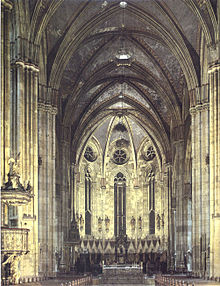 Cathedral of St Stephen in capital of Croatia, Zagreb, interior from 14th century
Cathedral of St Stephen in capital of Croatia, Zagreb, interior from 14th century
Largest urban project of those times was complete building of two new towns – Small and Large Ston, and about a kilometre of wall with guard towers between them (14th century). After Hadrian's wall in Scotland, the longest wall in Europe. That way all of Pelješac peninsula was surrounded and protected from land shore whit aim to protect the most valuable possession of Republic of Ragusa – salt from Ston.
We can recognize Gothic fortification with its high towers in shape of square prism from simple Romanesque one, or round Renaissance one. The best-preserved ones in Croatia are in Istria (Hum, Bale, Motovun, Labin etc.) and those on north (Medvedgrad above Zagreb from year 1260) or on the south Sokolac in Lika (14th century).
Franciscan church in Pula (1285) is the most representative example of Early Gothic. Simple one nave building with wooden rib-vault ceiling, with square apse and high stain windows was built from 13th to 15th century.
Tatars destroyed Romanesque cathedral in Zagreb during their scourge in 1240, but right after their departure Zagreb got the title of a free city from Hungarian king Bela IV. Soon after bishop Timotej began to rebuild the cathedral in new Gothic style. Building with three naves, polygonal apses and rib-vault had Romanesque round towers. The naves were built in 14th century, and the vault was finished in 15th. With the arrival of Turks in 16th century high walls and towers surrounded it. Only one tower was finished in 17th century, while in 18th the Baroque roof became the landmark of entire city. With the restoration in 19th century in Neo-gothic style it lost former harmony.
During the 14th century, the Split cathedral of St Duje and cluster of Franciscan monastery in Dubrovnik were also build.
In Dubrovnik after fire in 1435, two of the most important buildings, The Rector's Palace and the Sponza Palace, were restored in style of Venetian Gothic by an artisan from Naples - Onofrio della Cava.
Renaissance
Main article: Renaissance in CroatiaIn 15th century, Croatia was divided between three states – northern Croatia was a part of Austrian Empire, Dalmatia was under the rule of Venetian Republic (with exception of Dubrovnik) and Slavonia was under Ottoman occupation. Dalmatia was on the periphery of several influences, just as far from Italy as from Ottomans in Bosnia and Austrians in the north, so it thrived from all. In those circumstances in Dalmatia flourished religious and public architecture with clear influence of Italian renaissance, but still original.
Only in the kind of environment, free of dogmas and self-governed - far of major governing centers, could it be possible for artisan known as Giorgio da Sebenico (Juraj Dalmatinac) to build a church entirely by his own project – Cathedral of St.James in Šibenik, in 1441. Besides mixing of gothic and renaissance style it was also original by unity of stone building and montage construction (big stone blocks, pilasters and ribs were bounded with joints and slots on them - without concrete) in the way that was usual in wooden constructions. This was unique building with so-called three-leaves frontal and half-barrel vaults, first in Europe. The cathedral and its original stone dome was finished by Nikola Firentinac following the original plans of Juraj.
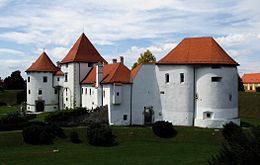 Renaissance walls of Varaždin
Renaissance walls of Varaždin
In the entire area of Republic of Ragusa there were numerous villas of nobility, unique by their functionality and space organization - combination of renaissance villa and government building. Sorkočević’s villa in Lapad near Dubrovnik in 1521 is original by order of building parts in asymmetrical, dynamical balance.
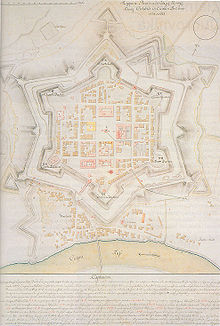 Renaissance star-shaped fortress in Karlovac (designed in 1579)
Renaissance star-shaped fortress in Karlovac (designed in 1579)
In northwestern Croatia, the beginning of the wars with the Ottoman Empire caused many problems but in the long term it both reinforced the northern influence (by having the Austrians as the rulers). With permanent danger by Ottomans from east, there was modest influence of renaissance, while fortifications thrived. The plan for fortified city of Karlovac in 1579 was first entirely new urban city to be built by renaissance plans (so called “ideal city” plan) in Europe. It was built in radial plan, later common in Baroque. Renaissance fort of Ratkay family in Veliki Tabor from 16th century has mixed features of gothic architecture (high roofs) and renaissance (cluster and round towers) making it an example of mannerism.
Baroque and Rococo
In 17th and 18th century Croatia was reunited with the parts of country that were occupied by Venetian Republic and Ottoman Empire. The unity attributed to sudden flourishing of Art in every segment. In northern Croatia and Slavonia sprung out numerous and worthy works of baroque art – from urban plans and large forts to churches, palaces, public buildings and monuments, all were done in Baroque style.
Large fortifications with radial plan, ditches and numerous towers were built because of constant Ottoman threat. The two largest ones were Osijek and Slavonski Brod. Later they become large cities. They were fortified with water and earth – earth mounds with cannons and canals filled with water that was supposed to slow dawn the approaching enemies. The fort of Slavonski Brod was the largest in all Croatia, and one of the largest ones in entire Europe because it was bounding fort of Europe toward Ottoman Empire.
Urban planning of Baroque is felt in numerous new towns like Karlovac, Bjelovar, Koprivnica, Virovitica etc. that had large straight streets, rectangular squares in the middle surrounded with buildings as government and military ones as well as representative church.
 The church of St Vlaho (St Blasius) in Dubrovnik by night
The church of St Vlaho (St Blasius) in Dubrovnik by night
Cities of Dalmatia also got baroque towers and bastions incorporated in their old walls, like the ones in Pula, Šibenik or Hvar. But biggest baroque undertaking happened in Dubrovnik in 17th century after catastrophic earthquake in 1667 when almost entire city was destroyed. In Baroque style were rebuilt the church of St Vlaho on the main square (1715), Main Chatedral and Jesuit monastery with church of St Ignatius. Paolo Passalaqua united several of those baroque masterpieces with his Jesuit Stairway. That beautiful wide stone stairway with series of convexities and concavities and strong balustrade (reminiscent of famous Spain Stairway Square in Rome) actually connected two separate baroque parts of the city - the Jesuit church above and Ivan Gundulić Square below.
During the Baroque numerous churches, enchanting us with their size and form were built in all Croatia, thus becoming a crown in every town or a city. The monastery churches often had an enclosing wall with inner porches lavishly decorated, like in Franciscan monastery in Slavonski Brod where the columns are as thick as baroque abundance. The most beautiful one is probably the church in Selima near Sisak. It has oval shape with elliptic dome and concave and convex front with two according towers.
Wall painting experienced flourishing in all parts of Croatia, from illusionist frescoes in church of Holy Mary in Samobor, St Catherine[disambiguation needed
 ] in Zagreb to Jesuit church in Dubrovnik. Best preserved ones are Rococo frescoes in Miljana mansion where allegorical seasons and natural elements were depicted through human nature and his reflection on art.
] in Zagreb to Jesuit church in Dubrovnik. Best preserved ones are Rococo frescoes in Miljana mansion where allegorical seasons and natural elements were depicted through human nature and his reflection on art.19th century
In Austrian countries on the beginning of 19th century (to which Croatia belonged than) building in Classicistic Manner prevailed. In Croatia most prominent architect was Bartol Felbinger who also build City Hall in Samobor (1826) and Januševac Castle near Zagreb.
Romantic movement in Croatia was sentimental, gentle and subtle – real image of bourgeoisie’s humble and modest virtues. In architecture there were simple decorations made of shallow arch like niches around windows.
Historicism is marked with building three large churches: neo-Romanesque cathedral in Đakovo (K. Roesner and F. Schmidt, 1882), monumental parish church of St Peter and Paul in Osijek (1898) and neo-gothic rebuilding of Zagreb cathedral with glazed roof tiles and 105 m tall towers (Herman Bolle, 1880–1902). At the end of 19th century Herman Bolle undertook one of the largest projects of European historicism – half-kilometer long neo-renaissance arcade with twenty domes on Zagreb cemetery Mirogoj.
At the same time the cities in Croatia got important urban makeover: Karlovac transformed its renaissance bastions into a parkway that surrounds entire old town (just like “Vienna Ring” ), while coastal cities (Trogir, Zadar, Pula, Pag and Šibenik) take down their walls and opened to the sea. But whit size and importance the urban regulation of Downtown Zagreb (largely the work of Milan Lenuzzio, 1860–1880) is revolutionary. Between Zagreb’s longest street – Ilica, and new railway the new geometrical city was built with large public and social buildings like neo-renaissance building of Croatian Academy of Science and Art (HAZU, F. Scmidt, 1884), neo-baroque Croatian National Theater (HNK, H. Helmer and F. Fellner, 1895), and to that date very modern Art Pavilion (1898) with montage construction of steel and glass – Croatian “Crystal Palace”, and finally the masterpiece of Art Nouveau – The National Library (Lubinski, finished in 1912). This urban plan is bounded with series of parks and parkways decorated with numerous fountains, sculptures, avenues and gardens (known as “Green Horseshoe”) making Zagreb one of first cities build according to new European art theory of “city as a work of art”.
Pseudo building that emphasizes all three visual arts is former building of Ministry of Prayer and Education in Zagreb (H. Bolle, 1895). Alongside with rooms in Pompeii style and renaissance cabinet, the large neo-baroque “Golden Hall” was painted with historic compositions. “The Golden Hall” becomes unified monument of its age, one of few in Europe.
20th century
HNK Ivana pl. Zajca in Rijeka
Till the end of World War I in Croatia there is coexistence of several art movements and styles, but all avant-garde movements are absent. That’s why the greatest artworks of that period are done in spirit of 19th century art. The most important architecture done in Viennas Art Nouveau (also called Sezessionsstil, 'Secessionism') is done at that time. Ethnographic Museum in 1901, Kalina House in 1903, National Library in 1912 was built in Zagreb, while Sulphurous Bath in 1903, and Croatian National Theatre in 1908, are build in Split.
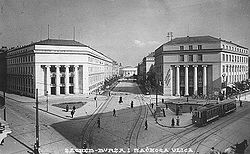 Photo taken in early 30s of Burze square (Viktor Kovačić) in Zagreb.
Photo taken in early 30s of Burze square (Viktor Kovačić) in Zagreb.
The modern Croatian architecture appeared with Viktor Kovačić who was the first to speak against historicism and represented the idea that architecture must be individual and modern, but also practical and comfortable. His projects are marked with subtle purity of reduced elements of historicism, like in monumental Palace of Burze in Zagreb, 1924. From the thirties the works of “Zagreb school” of architecture can stand alongside with the best world architecture. They are especially interesting because of merging of two opposite directions in architecture of those days – functionalistic and organic.
Drago Ibler has published a manifest of group “Earth” in which he says: “We should live in the spirit of our age and create accordingly; … The modern life is full of social ideas and questions considering everybody and an artist can’t stand outside that collective because art and life are one.” Most of his projects were rejected, and out of the ones that were actually done extraordinaire is the building of Social Security in Mostar. Today the simple ambulance, build in 1930, have a beautiful convex half-ring shaped entrance with a porch, and dynamical balance of short office building and tall volume of resident part and stairways.
Stjepan Planić, also a member of group “Earth”, with his numerous buildings have made a makeover of Zagreb and earned a place in Anthology of Modern Architecture. Every project of his is marked with some new idea: Villa in Kozarčeva street from 1931 is gradually accommodated to the hillside, “Tomislav Home” in Sljeme from 1935, made out of wood and stone, has unique plane in the shape of letter Y, circular villa on the Prekrižje, also from 1935, has radial inner walls, while “Napredak” building from 1936 has unique oval plan. He fought for the architectural freedom to plan the buildings accordingly with climatic conditions, the sun, the wind and the sightings, and for the affirmation of new social and human ideas in habitat culture.
Recent architectural directions
See also
Part of a series on the Culture of Croatia 
Timeline History of Croatia Medieval Kingdom Renaissance National Revival Culture and Traditions Alka · Cuisine · Dance · Dress · Easter egg · Language · Tamburica · Tattoos · Wine Arts Art · Architecture · Cinema · Literature · Music Religion Religion · Christmas Eve · Our Lady of Sinj · Marija Bistrica · Our Lady of Međugorje · Saint Joseph · St. Mark's Church · Old Church Slavonic Society Education · Nature parks · Matica hrvatska · Sport · Radio · Television · World Heritage Sites Symbols Flag · Coat of Arms · Anthem · Licitar · Wattle
Croatia Portal
- Art of Croatia
- Church of Saint Cross
- Hollow Church
Sources
Architecture of Europe By country Albania · Armenia · Austria · Azerbaijan · Belarus · Belgium · Bosnia and Herzegovina · Bulgaria · Croatia · Cyprus · Czech Republic · Denmark · Estonia · Finland · France · Georgia · Germany · Greece · Hungary · Iceland · Ireland · Italy · Kazakhstan · Latvia · Lithuania · Luxembourg · Macedonia · Malta · Moldova · Montenegro · Netherlands · Norway · Poland · Portugal · Romania · Russia · Serbia · Slovakia · Slovenia · Spain · Sweden · Switzerland · Turkey · Ukraine · United Kingdom (England · Scotland)History Ancient Greek · Roman · Byzantine · Pre-Romanesque · Romanesque · Romano-Gothic · Gothic · Renaissance · Baroque · Biedermeier · Classicism · Neoclassical · Historicism · Gründerzeit · Gothic Revival · Neo-Renaissance · Neo-Baroque · Rationalism · Modernisme · Art Nouveau · Expressionism · Modern · PostmodernCategories:- Croatian architecture
Wikimedia Foundation. 2010.


